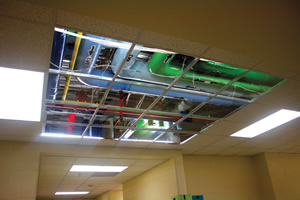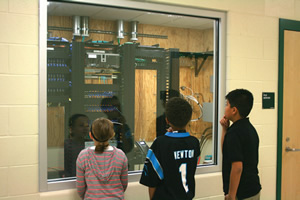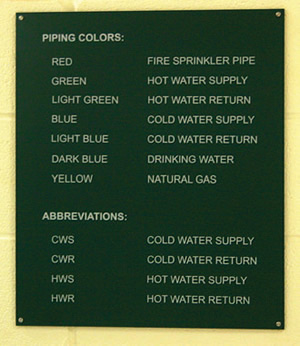How Technology is Reshaping Instructional Space

PHOTOS COURTESY OF SUTTON FIELDS
Technology has been reshaping our spaces for some time now. The ability to move walls and expand or shrink space with the stroke of a cursor has mesmerized facility planners since the late 1970s when computer-aided drafting and design became commercially available. Three-dimensional Building Information Management (BIM) is just the latest version of the story. But the use and presence of instructional technology — as well as building systems technology — is now causing us to re-think the shape and design of instructional spaces.
Bill Latham, CEO of Contrax Furnishings in Gainesville, Fla., is in the business of helping school districts adapt their classrooms and furnishings to changes in instructional delivery. He states, “In order to respond to the rigors of technology, spaces must adapt to instruction in specific ways. They must support sharing (mobile and collaborative). Instructional spaces must support formal and informal learning as well as the multiple modalities of learning. Above all, spaces must be flexible.”
Delivery methods of the education program in today’s school facilities vary significantly, although a common theme at every grade level is the need for flexible space. Learning no longer needs to be confined to the four walls of the traditional classroom, with all eyes and ears focused on the teacher at the front of the classroom. School facility design professionals are challenged to offer instructional spaces that lend themselves to be configured for multiple learning styles. There is an evident shift in today’s classroom from the traditional “teacher-centered” environment to one that is “student-centered.” creating a need for space that can easily be reconfigured from large group settings to smaller project based areas, or to make room for individual study and exploration.


Watch and Learn. Students at Palisades Park Elementary School look through glass-viewing areas that were installed in selected classroom corridors so they can observe the building’s use of electricity, gas and water in real time. Adjacent signage provides information regarding abbreviations and color-coding. The district also implemented a web-based system called Building OS so students also access the information from school or home computers.
Smaller instructional areas
As student-centered learning environments become the norm rather than the exception, technology is allowing us to re-think classroom groupings and even classroom square footage. Not too long ago, a classroom of less than 750 square feet was considered non-standard and was marginalized as a conference room or storage room. Smaller instructional spaces are now regularly designed into new buildings as teaching stations for small group instruction, tutoring and self-paced learning environments. Student groupings become far more flexible when technology is used. Student-teacher ratios are no longer fixed, so classroom sizes are variable as well. Larger existing spaces are repurposed as interactive desktop labs or virtual academies. Cafeterias configured as food courts accommodate small informal instructional groups throughout the school day. Smaller spaces and corridor niches are used for tutoring or discussion groups.
Distance or blended education
The headquarters of the Cardinal Academy at Taylor County High School in Campbellsville, Ky., looks more like a student lounge than an instructional space — lots of soft seating, very few tables and chairs. The Cardinal Academy is a wholly independent study program within the high school. It is possible because all of the high school’s classes and many of the local university’s classes are available online. The work is self-paced and based upon a student’s current interests. The prevalence of technology also allows students to learn off-campus and outside of school hours.
It is obvious that as technology reshapes our definitions of instructional spaces, we will be required to vacate our comfort zones. There will be schools in which students will be encouraged to bring and use their own technology, including their cell phones. Groups of students will use whatever space is available to study and to learn. Some may not be on campus. And teachers will be able to easily differentiate lessons, because they can either connect to all of their students’ devices at once, in groups or learning levels, or with an individual student to follow their daily progress. Educators are using these tools to minimize learning loss when students are home because of illness or inclement weather. A teacher in New York recently posted her experience of using video conferencing to teach her classes from home while she was ill with the flu.
Building systems technology
Along with classroom and instructional technology, building systems technology is also contributing to changes in school design. Students attending the recently opened Palisades Park Elementary School in Charlotte, N.C., have a unique opportunity to incorporate the operating functions of the building into the curriculum. Rather than hiding electrical and data equipment rooms, glass-viewing areas are installed in selected classroom corridors. Students can also examine insulated HVAC piping, wiring and cabling behind Plexiglas ceiling tiles at a primary hallway intersection. Adjacent signage provides information regarding abbreviations and color-coding. Project architect Nancy Zaremski, with WHN Architects, said, “In brainstorming sessions with district staff, we explored different ways to connect the building itself with STEM curriculum. Our major focus on exposing building systems and construction materials was intended to help children understand the inner workings of a school facility.”
Use of operations data
Another example of technology reshaping space relates to students having access to and using operations data for experiential able to observe the building’s use of electricity, gas and water in real time. The district implemented a web-based system called Building OS developed by Lucid, an energy software company based in Oakland, Calif. The software is programmed to read data from pulse meters tied into the facility’s building automation system. Energy data is continuously uploaded to Lucid’s software, which can be seen on four large screen monitors mounted at the entrance to the cafeteria and primary corridors. Students also access the information from school or home computers on a customized “Building Dashboard” website.
Challenges
Adapting instructional space in existing facilities certainly presents significant challenges. Will technology give us the ability to adapt these older schools to 21-century teaching methods? Or do existing configurations hinder the full use of technology? Early results seem to indicate just the opposite. It is likely the educational innovators among us are so driven that a little thing like traditional space configurations will not constrain their use of technology. As multiple student and teacher devices become ubiquitous, it will be wireless access speed and capacity that will constrain the use of technology within the learning environment, not square footage or space configuration.
More and more, school designers are beginning to utilize space outside of the classroom, providing students with informal settings for tutoring, small work groups, or individualized study. Once again, flexibility of space is a key factor, and use of portable devices allows students to connect to available resources. Moving instructional space into corridors and other common space in the school is not without challenges, particularly in older schools. Placing moveable furniture in corridors, stairways, or near exit doors can potentially restrict egress and may violate fire code. Security concerns may also arise when students are provided with nontraditional instructional space outside of the confines of the classroom.
For many people, schools and the spaces within are not all that different than the ones they attended when they were young. Our new school buildings still look very much like traditional schools. Once inside the front door, however, it only takes a moment to recognize and appreciate the significant ways technology has impacted instructional space.
This article originally appeared in the issue of .